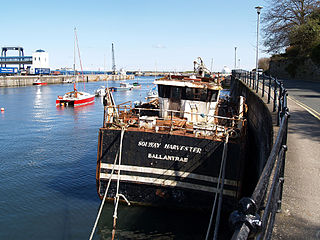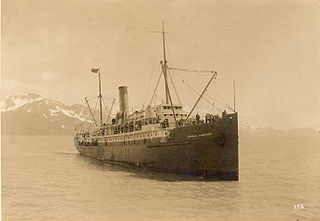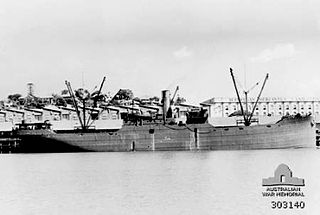
SS Edmund Fitzgerald was an American Great Lakes freighter that sank in Lake Superior during a storm on November 10, 1975, with the loss of the entire crew of 29 men. When launched on June 7, 1958, she was the largest ship on North America's Great Lakes, and she remains the largest to have sunk there. She was located in deep water on November 14, 1975, by a U.S. Navy aircraft detecting magnetic anomalies, and found soon afterwards to be in two large pieces.

The SS English Trader was a British merchant ship wrecked off the coast of Norfolk, England in October 1941. After falling behind a convoy during the Second World War of which she was a part, the ship ran aground on the Hammond's Knoll sandbank and began to break up during a gale. Several rescue attempts by lifeboats failed, but a further attempt the following day by the Cromer Lifeboat rescued 44 of the crew, three having already been lost.

The Solway Harvester was a scallop dredger from Kirkcudbright, Scotland which sank off the coast of Douglas, Isle of Man in heavy seas on 11 January 2000 with the loss of all seven crew members. Following salvage, the damaged ship was taken to Douglas, where she remained until dismantled for scrap in January 2014.

A lifeboat or liferaft is a small, rigid or inflatable boat carried for emergency evacuation in the event of a disaster aboard a ship. Lifeboat drills are required by law on larger commercial ships. Rafts (liferafts) are also used. In the military, a lifeboat may double as a whaleboat, dinghy, or gig. The ship's tenders of cruise ships often double as lifeboats. Recreational sailors usually carry inflatable liferafts, though a few prefer small proactive lifeboats that are harder to sink and can be sailed to safety.


The Great Lakes freighter SS Henry Steinbrenner was a 427-foot (130 m) long, 50-foot (15 m) wide, and 28-foot (8.5 m) deep, dry bulk freighter of typical construction style for the early 1900s, primarily designed for the iron ore, coal, and grain trades on the Great Lakes. Commissioned by the Kinsman Transit Co. of Cleveland, Ohio she was launched as hull number 14 by Jenks Ship Building Co. of Port Huron, Michigan. Her design featured a forward forecastle containing crew cabins topped with an additional cabin and pilot house. The mid section was a long nearly flat deck over the cargo holds only interrupted by 12 hatches fitted with telescoping type hatch covers. The aft end featured a large cabin situated over the engine room containing the galley, mess rooms, and crew quarters and was topped with a smoke stack and air vents. The Steinbrenner later featured a "doghouse" cabin aft of her smoke stack to house added crew from a change in the crew watch system on the Great Lakes.

The MV European Causeway is a ferry operated by P&O Ferries. She was built at Mitsubishi Heavy Industries Shimonoseki shipyard in Japan.

SS Monroe was an Old Dominion Steamship Company steamship launched 18 October 1902 and completed 3 April 1903 by Newport News Shipbuilding of Norfolk, Virginia for operation in the company's Old Dominion Line's "Main Line Division" for overnight service between New York and Norfolk and could make 16 knots (30 km/h). The ship had accommodations for 150 first class, 78 steerage and 53 deck passengers. That service was between New York pier 26, North River, and Norfolk connecting with the line's "Virginia Division" steamers, including Old Dominion's "Night Line Steamers" Berkley and Brandon serving Richmond with overnight service to Norfolk, other steamer lines and rail lines serving the Chesapeake Bay area. The Monroe was struck at about 2 a.m. on 30 January 1914 by the southbound steamer Nantucket and sank with loss of forty-one lives.
German submarine U-576 was a Type VIIC U-boat of Nazi Germany's Kriegsmarine during World War II. She carried out five patrols, sinking four ships of 15,450 gross register tons (GRT) and damaging two more of 19,457 GRT. She was sunk on 15 July 1942 by depth charges from two US aircraft and gunfire from a merchant ship, near the East Coast of the United States. The wreck was discovered in August 2014.

The SS Admiral Sampson was a U.S.-flagged cargo and passenger steamship that served three owners between 1898 and 1914, when it was rammed by a Canadian passenger liner and sank in Puget Sound. Following its sinking off Point No Point, the Admiral Sampson has become a notable scuba diving destination for advanced recreational divers certified to use rebreathing equipment.

MV Höegh Osaka is a roll-on/roll-off car carrier ship that was built in 2000 as Maersk Wind for A P Møller, Singapore. She was sold to Höegh Autoliners in 2008 and later renamed Höegh Osaka in August 2011. On 3 January 2015 she developed a severe list and was intentionally grounded in the Solent. Her 24 crew and a pilot were subsequently rescued.
The Cemfjord was a Cyprus-registered cargo ship which foundered in the Pentland Firth off the north-east coast of Scotland on 2 January 2015. Built as the general cargo ship Margareta in 1984, she was converted to carry cement in 1998 and was en route from Aalborg, Denmark to Runcorn, Cheshire, United Kingdom when she capsized in bad weather and sank in 82 metres (270 ft) of water. All eight crew were presumed lost. No bodies were recovered, and the ship has been left as a sea grave.

Tejuca was a small 470-ton clipper ship built in Hoboken, New Jersey in 1854. After only eighteen months of service, she was lost in a hurricane on the North Atlantic, with most of her crew rescued through a daring maneuver carried out by the ship Excelsior.

SS Coast Trader was built as the cargo ship SS Holyoke Bridge in 1920 by the Submarine Boat Company in Newark, New Jersey. The Coast Trader was torpedoed and sank 35 miles (56 km) south west of Cape Flattery, off the Strait of Juan de Fuca in U.S. state of Washington by the Japanese submarine I-26. Survivors were rescued by schooner Virginia I and HMCS Edmundston. She rests on the ocean floor at.













